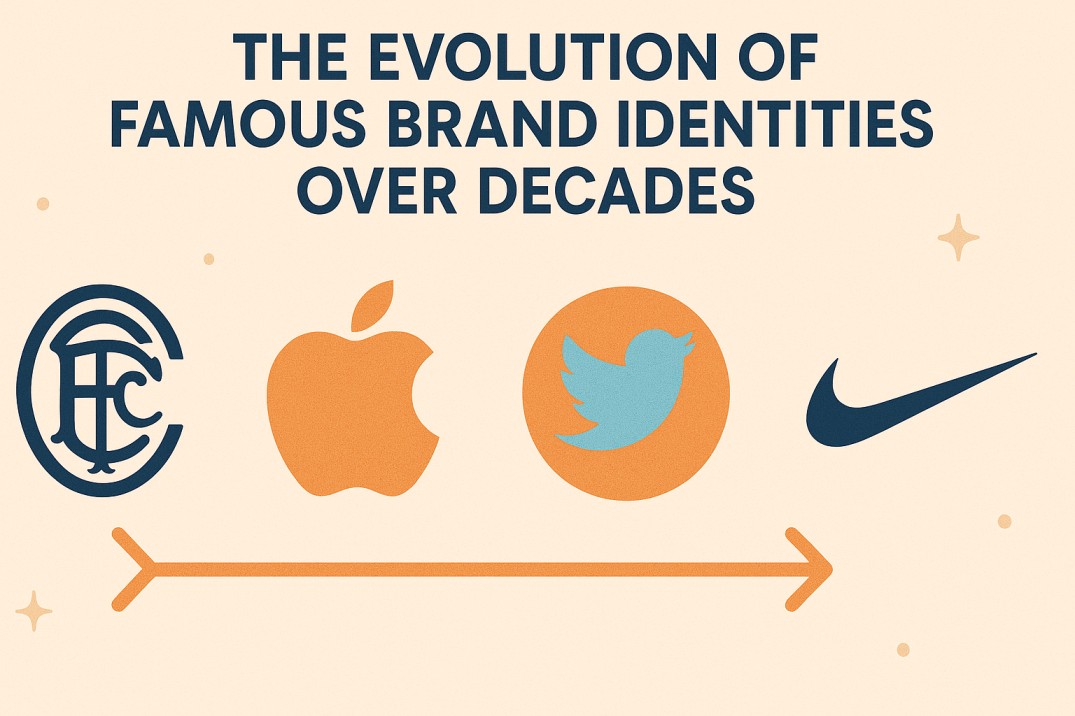To start with, in the ever-changing world of business, one truth always remains constant: a brand that stays relevant must evolve. For example, over the decades, some of the world’s most iconic companies have transformed their identities, thereby highlighting the famous brand identities evolution—not just for aesthetics, but also to reflect shifts in culture, technology, and consumer expectations. Moreover, studying the famous brand identities evolution is like watching a time-lapse of business strategy, creativity, and market adaptation. Consequently, it’s a fascinating journey that offers powerful lessons for modern brands of all sizes.
What Is Brand Identity?
At its core, brand identity is how your brand presents itself to the world. In fact, it includes everything from the logo and color palette to tone of voice, messaging, and overall design language. But it’s more than just visuals—brand identity shapes how consumers perceive and connect with a company.
Additionally, a strong identity helps build recognition, trust, and emotional loyalty. It signals who you are, what you stand for, and why you matter. Furthermore, as time goes on, that identity must often adapt to stay aligned with evolving values, markets, and customer needs.
The Early Days of Famous Brand Identities Evolution
Firstly, let’s rewind to when household names were just starting to carve out space in consumers’ minds, thereby beginning the famous brand identities evolution.
- Coca-Cola (1886): To begin with, one of the earliest examples of a globally recognized brand, Coca-Cola’s original logo was a highly ornate, handwritten script. While the typography has modernized over time, it has always maintained its classic red-and-white color scheme and signature cursive style— thus, a nod to its heritage.
- Apple (1976): Similarly, Apple’s first logo featured Isaac Newton sitting under a tree—an incredibly detailed illustration, far from the minimalist Apple we know today. However, by 1977, the iconic bitten apple was born, evolving over the years from rainbow stripes to sleek monochrome.
- Nike (1971): The Swoosh, originally paired with the word “Nike,” was created for just $35. Over time, Nike dropped the wordmark and let the Swoosh stand on its own—a powerful symbol of motion, empowerment, and excellence.
- McDonald’s (1940): Lastly, from the original barbecue-themed branding to the golden arches of today, McDonald’s shifted from local diner vibes to a global symbol of fast food culture.
Undoubtedly, These early designs laid the foundation—but what makes these brands stand out is their ability to transform while staying true to their essence.
Decades of Famous Brand Identities Evolution
1980s-1990s:
- During this period, brands embraced bold, colorful logos with geometric shapes and gradients (think Pepsi or Microsoft).
- Additionally, the taglines became more emotionally charged and aspirational (“Just Do It: By Nike“).
2000s:
- The digital boom led to simplification. As a result, logos became flatter and more responsive for online use.
- Websites and digital experiences became integral to the brand identity.
2010s-Present:
- Minimalism reigns. For instance, brands strip down to essential elements for clarity and versatility across devices.
- Authenticity and purpose-driven messaging come forward.
- Consistent visual storytelling on social media plays a huge role in how a brand is perceived.
Cultural and Market Influences on Brand Evolution
Over the years, several external factors have driven these transformations:
- Technology: As screens became the primary touchpoint, brands needed mobile-friendly, scalable logos.
- Globalization: Brands adapted identities for cross-cultural appeal.
- Consumer Behavior: A growing preference for authenticity, transparency, and sustainability has reshaped brand tone and messaging.
- Design Trends: From gradients to flat design to 3D elements—design aesthetics have followed broader cultural and artistic movements.
Evolve or Stay Static? The High Stakes of Identity
The benefits of evolving your brand identity include:
- Staying relevant and modern
- Reaching new audiences
- Better digital performance and brand recall
The risks of not evolving include:
- Appearing outdated or out of touch
- Losing engagement from younger consumers
- Falling behind more agile competitors
Lessons for Modern Businesses
- Evolution doesn’t mean losing your identity – For example, Coca-Cola and Nike have modernized without straying from their core DNA.
- Listen to your audience – Feedback and market trends should guide your transformation.
- Design with purpose – Since every change should reflect strategic goals, not just aesthetics.
- Adapt for platforms – Ensure your branding works across print, digital, mobile, and social.
Brand Evolution Reflects Growth
Just like people, brands must grow, mature, and adapt to stay alive. In fact, the most successful brand identities aren’t frozen in time— instead, they evolve in sync with their audience and the world around them.
At Fuel IT Online, we specialize in building and evolving your brand identity that resonates. Whether you’re launching a startup or refreshing your legacy brand, our team can help you craft a visual and verbal identity that feels timeless, modern, and authentically you. Get in touch and let’s future-proof your brand—together.




